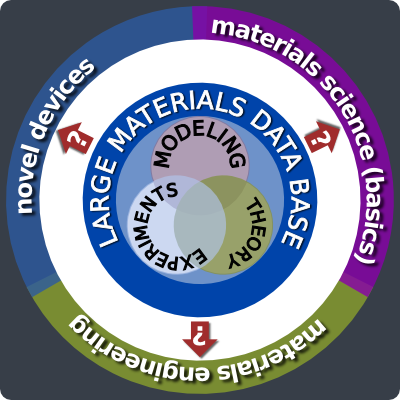White nights of materials science:
From physics and chemistry to data analysis, and back
Saint Petersburg, Russia, June 16-20, 2014,
|
Welcome Arrival
Contact |
Scope of the meetingIn recent years, the rapid development of both computer hardware and electronic-structure software has made first-principles materials design not only feasible, but also a powerful and cost-effective alternative to experimental screening approaches. It has also opened up new possibilities and with them new challenges. On the first-principles modelling side, the challenges are the identification and production of the key common and application-specific data, computational-data reliability and accuracy, and the development of multiscale approaches with control of error propagation across different scales. On the data-analysis side, the challenge is the development of a comprehensive materials data structure and analysis tools that are capable of handling large amounts of data.  Usually, the specifics of a particular area of computational research, and data storage and analysis issues are considered as separate. Computational materials scientists usually assume that their data is not of the quantity that merits the attention from a database expert, or detailed analysis, and indeed rarely consider data that are not central to a specific project. Database specialists often abstract data from its origin. As a result, there are still only few experts in both advanced electronic-structure theory and database structure/analysis, while communication between experts in these different fields is often difficult because they speak different "languages". Overcoming these barriers has the potential to change how research is done worldwide. On one hand, much of computational data that are often discarded (for example, method validation studies, wave functions, information on the potential-energy surface obtained during atomic relaxation, molecular dynamics, or a genetic-algorithm run) could be stored and used to determine hidden correlations and find descriptors that facilitate the exploration of a vast compositional space across multiple time and length scales. On the other hand, novel data analysis could reveal what data are still missing, providing a rational motivation for new computational studies. The planned workshop is intended to bring together researchers who are experts in electronic-structure theory or database structure/analysis, interested in both fields. We intend to create an environment where communication between people with different expertise and backgrounds is strongly encouraged, in order to understand and overcome barriers on all sides. Advances in electronic-structure method development, multiscale modelling, materials data analysis, and machine learning will be discussed in close connection with technologically important applications, such as heterogeneous catalysis, thermoelectric materials, optoelectronics, hybrid organic-inorganic interfaces, and others. The goals of the workshop are to identify: both common and application-specific features of a comprehensive materials data structure, specific areas where data analysis would be especially helpful, and the availability or absence ("blind spots") of data. ParticipationThe registration is now closed. No further applications will be accepted.
Important Deadlines
|